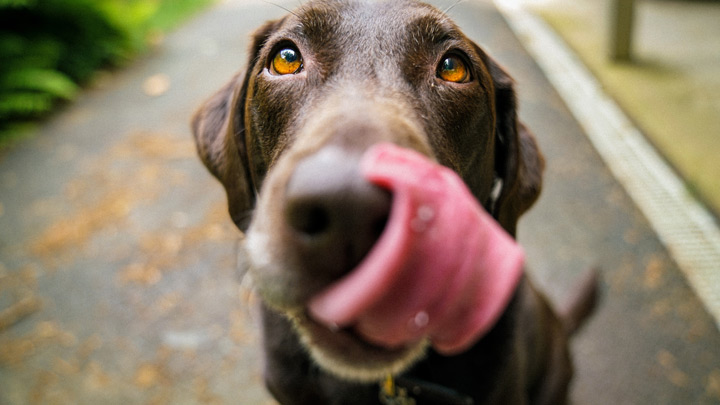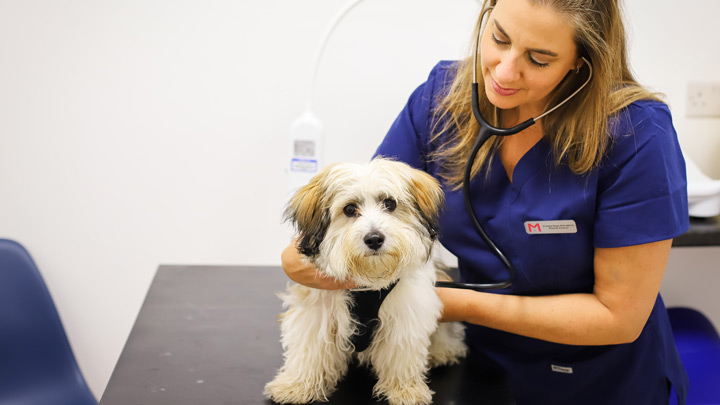Gum Disease in Dogs
Gum disease in dogs is one of the most common health conditions affecting our canine companions, yet it often goes unnoticed until serious complications develop. If the early stages of gum disease are ignored, periodontal disease can develop. This progressive bacterial infection starts with plaque buildup on teeth and can lead to tooth loss, chronic pain and systemic health problems if left untreated. Understanding the signs, stages and treatment options for periodontal disease in dogs helps protect your pet's oral health and overall wellbeing.
What is Periodontal Disease in Dogs?
Periodontal disease, commonly called gum disease in dogs, is a bacterial infection affecting the structures that support teeth, including gums, periodontal ligament and jawbone. The condition begins when bacteria in your dog's mouth accumulate and develop into plaque, a sticky film that coats teeth within hours of cleaning.
Without regular removal, plaque hardens into tartar. This rough surface provides an ideal environment for more bacteria to multiply, creating a cycle of infection and inflammation. As bacteria spread below the gum line, they release toxins that damage surrounding tissues and trigger an inflammatory response from your dog's immune system.
The progression from healthy gums to advanced periodontal disease can occur relatively quickly in dogs, particularly in smaller breeds and those with crowded teeth. Unlike humans, dogs rarely develop cavities; instead, periodontal disease represents their primary dental health concern.
Causes of Dental Disease in Dogs
Several factors contribute to the development of dental disease in dogs. Poor oral hygiene remains the leading cause, as infrequent brushing allows plaque and bacteria to accumulate unchecked. Without daily removal, this bacterial film mineralises into tartar that professional cleaning can only remove.
Breed predisposition plays a significant role in dental health. Small and toy breeds like Yorkshire Terriers, Maltese and Chihuahuas face increased risk due to crowded teeth that trap food and bacteria. Brachycephalic (flat-faced) breeds like Pugs and French Bulldogs experience increased dental problems due to misaligned teeth.
Diet and nutrition directly impact oral health. Soft, sticky foods cling to teeth and promote bacterial growth. Dogs fed exclusively soft diets or table scraps typically develop more severe dental issues.
Age and immune system factors influence disease progression. As dogs age, their immune response weakens, making them less capable of fighting oral bacteria. Additionally, certain systemic conditions like diabetes compromise immune function and accelerate periodontal disease development.
Genetic factors affect some dogs regardless of care quality. Some individuals naturally produce more plaque or have weaker tooth enamel, requiring more intensive preventive measures throughout their lives.
Signs and Symptoms of Gum Disease
Recognising early symptoms of gum disease in dogs allows for prompt intervention before irreversible damage occurs. Bad breath (halitosis) typically appears first, though many owners mistakenly accept "doggy breath" as normal. Healthy dogs should have neutral-smelling breath; persistent foul odour indicates bacterial overgrowth.
Visual signs include:
- Red, swollen or bleeding gums
- Yellow-brown tartar buildup on teeth
- Receding gum line exposing tooth roots
- Loose or missing teeth
- Pus around teeth and gums
Behavioural changes can signal dental pain:
- Reluctance to eat hard food or treats
- Dropping food whilst eating
- Chewing on one side of the mouth
- Pawing at the face or mouth
- Unusual drooling or blood-tinged saliva
- Withdrawal from play or decreased activity
Advanced periodontal disease may cause facial swelling, particularly below the eye, indicating tooth root abscess. Some dogs develop nasal discharge or sneezing when infection spreads to nasal passages. Weight loss can occur when eating becomes too painful.

Four Stages of Periodontal Disease
Veterinary professionals classify periodontal disease in dogs into four distinct stages based on attachment loss and damage severity.
Stage 1: Gingivitis
Gingivitis represents the only reversible stage of periodontal disease. Gums appear red and swollen but haven't yet detached from teeth. Plaque and early tartar accumulation visible above the gum line. With professional cleaning and improved home care, complete recovery is possible. No permanent damage has occurred to supporting structures.
Stage 2: Early Periodontitis
At this stage, infection spreads below the gum line causing up to 25% attachment loss between teeth and supporting structures. Gum pockets begin forming where bacteria accumulate. Bone loss starts but isn't yet visible on X-rays. Professional cleaning under anaesthesia, including subgingival scaling, can halt progression but damage cannot be reversed.
Stage 3: Moderate Periodontitis
Attachment loss reaches 25-50% with visible gum recession and deepening pockets. Significant bone loss appears on dental X-rays. Teeth may become loose or shift position. Treatment involves deep cleaning, possible gum surgery and selective tooth extractions. Managing pain and infection becomes a priority alongside halting disease progression.
Stage 4: Advanced Periodontitis
More than 50% attachment loss with severe gum recession, deep pockets and extensive bone destruction. Multiple loose teeth require extraction or treatment. Risk of jaw fracture increases, particularly in small breeds. Bacteria entering the bloodstream through damaged tissues can affect the heart, liver and kidneys. Treatment focuses on treating or removing infected teeth, managing pain and preventing systemic complications.
Diagnosis and Dental Examinations
Proper diagnosis of dental disease in dogs requires comprehensive examination under general anaesthesia. Whilst conscious oral checks provide initial assessment, complete evaluation of periodontal health necessitates detailed probing and imaging impossible in awake patients.
During examination, your vet measures pocket depths around each tooth using a periodontal probe. Normal sulcus (the space between the surface of the tooth and the surrounding gum tissue) depth measures 1-3mm in dogs; deeper pockets indicate attachment loss and active infection. Each tooth receives individual assessment for mobility, fractures and gum recession.
Dental X-rays reveal crucial information invisible during visual examination. These images show:
- Bone loss around tooth roots
- Tooth root abscesses
- Fractured roots below gum line
- Retained tooth roots from previous extractions
- Jaw bone integrity
Full-mouth radiographs may help to detect problems in apparently healthy teeth, as significant disease often exists below the gum line without external signs. Studies show dental X-rays change treatment plans in a substantial percentage of cases.
Your vet documents findings on a dental chart, recording each tooth's condition for future comparison. This systematic approach tracks disease progression and treatment effectiveness over time.

Treatment Options for Gum Disease
Treatment for gum disease in dogs varies based on disease stage and individual tooth condition. Professional dental cleaning under general anaesthesia forms the foundation of treatment, allowing thorough removal of plaque and tartar both above and below the gum line.
Professional scaling and polishing involves:
- Ultrasonic scaling to remove tartar deposits
- Hand scaling for stubborn calculus (hardened dental plaque)
- Subgingival curettage (the process of removing diseased soft tissue) to clean root surfaces
- Polishing to smooth enamel and slow plaque reattachment
For advanced cases, surgical intervention may include:
- Tooth extractions for severely diseased teeth
- Gingival flap surgery to access deep pockets
- Bone grafting in select cases
- Root planing to remove infected cementum (the hard tissue covering the surface of a tooth's root)
Post-treatment care typically involves:
- Pain management with appropriate medications
- Antibiotics when infection is present
- Soft food during the healing period
- Follow-up examinations to monitor recovery
Your veterinary team tailors treatment plans based on your dog's specific needs, considering factors like age, overall health and disease severity.
Prevention Through Daily Oral Care
Preventing periodontal disease requires consistent daily oral care - and may need to be combined with regular professional cleanings. Daily tooth brushing removes plaque before it hardens into tartar, representing the single most effective preventive measure owners can implement.
Starting a brushing routine:
- Choose dog-specific toothpaste (never use human toothpaste)
- Select an appropriately sized toothbrush or finger brush
- Begin gradually with brief sessions
- Reward cooperation with praise and treats
- Aim for 2-3 minutes daily, focusing on outer tooth surfaces
Alternative dental care options supplement but don't replace brushing:
- Dental chews approved by the Veterinary Oral Health Council
- Water additives that reduce bacterial growth
- Prescription dental diets with kibble designed to clean teeth
- Dental toys that promote chewing and saliva production
Professional preventive care includes:
- Annual dental examinations during routine check-ups
- Professional cleanings based on individual needs
- Early intervention for developing problems
- Monitoring high-risk breeds more frequently
Establishing good oral hygiene habits during puppyhood creates lifelong benefits. Even adult dogs can learn to accept tooth brushing with patience and positive reinforcement.
When to See Your Vet
Knowing when to seek veterinary dental care helps prevent minor issues becoming serious problems. Schedule an appointment if you notice bad breath persisting despite home care, visible tartar accumulation, or any behavioural changes suggesting oral discomfort.
Urgent veterinary attention is needed for:
- Facial swelling or discharge
- Bleeding from the mouth
- Inability to close mouth properly
- Sudden refusal to eat
- Excessive drooling or pawing at mouth
Regular dental checks should occur:
- Every 6-12 months for adult dogs
- More frequently for senior dogs or high-risk breeds
- Following any dental procedure for monitoring
- As part of annual health examinations
Early detection through regular dental checks at Medivet allows for less invasive treatment and better outcomes. Our veterinary teams assess your dog's oral health during routine consultations and recommend appropriate preventive care schedules.

Is your dog showing signs of gum disease?
Don't wait for symptoms to worsen. Book a dental check at your local Medivet practice today. Our experienced veterinary teams provide comprehensive oral examinations and create tailored treatment plans to protect your dog's dental health. With dental facilities and caring professionals, we help keep your dog's smile healthy for life.
Book a dental check at your nearest Medivet practiceGum disease in dogs represents a serious but preventable health condition affecting the majority of adult dogs. Understanding the causes, recognising early symptoms and implementing daily preventive care protects your dog from pain, tooth loss and systemic health complications. With proper home care combined with any necessary regular professional dental cleanings, most dogs can maintain healthy teeth and gums throughout their lives. Partner with your Medivet veterinary team to establish an oral health programme tailored to your dog's specific needs and risk factors.
Frequently Asked Questions
Treatment for gum disease in dogs depends on severity but typically involves professional dental cleaning under anaesthesia to remove plaque and tartar. Early-stage gingivitis can be reversed with thorough cleaning and improved home care. Advanced cases may require tooth extractions, antibiotics and pain management, followed by regular dental care to prevent recurrence.
Dogs can live normal lifespans with properly managed gum disease, though untreated periodontal disease significantly impacts quality of life and can shorten lifespan. The bacteria from severe dental disease can affect major organs including the heart and kidneys. With appropriate treatment and ongoing preventive care, most dogs maintain good health despite previous dental issues.
Gum disease in dogs appears as red, swollen gums that may bleed easily, yellow-brown tartar on teeth, and receding gum lines. You might notice bad breath, loose teeth, or your dog favouring one side when chewing. Advanced stages show exposed tooth roots, pus around teeth, and facial swelling. It is of note that early stage gum disease may not be visually recognisable.
The four stages are: Stage 1 (Gingivitis) - reversible inflammation with red, swollen gums; Stage 2 (Early Periodontitis) - up to 25% attachment loss with early bone loss; Stage 3 (Moderate Periodontitis) - 25-50% attachment loss with visible gum recession; Stage 4 (Advanced Periodontitis) - over 50% attachment loss requiring multiple extractions.

